Kenneth L. Gentry Jr.'s Blog, page 36
June 10, 2022
CULTURAL MANDATE & GREAT COMMISSION (2)
 PMW 2022-044 by Kenneth L. Gentry, Jr.
PMW 2022-044 by Kenneth L. Gentry, Jr.
This is the second in a two-part series looking into the relationship between the Great Commission and the Cultural Mandate (Gen 1:26–28). Both mandates feed the postmillennial hope.
There are a few evangelicals who disassociate the Creation (or Cultural) Mandate from the Great Commission, which has also been called the New Creation (or Evangelistic) Mandate. This is an unfortunate mistake that detracts from the greatness of the Great Commission and a proper engagement of the Christian calling in the world. Nevertheless, the two mandates are intimately related. This may be seen from several considerations.
Both Mandates are Granted at Strategic Times
In its setting, the Creation Mandate occurs as the “swelling of jubilant song” at the accomplishment of God’s creative activity. At that time, the creation had just been completed and pronounced “very good” (Gen. 1:31-2:2). Genesis declares that “God finished His work.” The Greek word for “finished” here is suntetelesen, which is based on the root word teleo. On the basis of the completion of God’s work, the joyful declaration is given.
The New Creation Mandate, too, occurs at the climax of divine labor. It was given at the completion of Christ’s work in securing man’s redemption, not long after He declared, “It is finished” (John 19:30). His statement in the Greek is tetelestai, which is based on the root word teleo, the same root found in the statement in Genesis 2:2.
Because of the work of Christ, a “new creation” has begun; there are several verses that speak of salvation as a new creation. The old creation involves the material world in which we live; the new creation involves the spiritual world, which governs the life we live as saved creatures. Consequently, the old creation and new creation correspond to one another. Thus, the Creation Mandate and the New Creation mandate supplement each other, as well.
Both Mandates Claim the Same Authority
The ultimate authority of the Triune God specifically undergirds both the Creation and the New Creation Mandates. The Creation Mandate was given directly from the mouth of God, who had just created all reality by means of His spoken word (Gen. 1:26-31). This was the very God who said, “Let Us make man in Our image” (Gen. 1:26), thus indicating His Trinitarian being.

As It Is Written: The Genesis Account Literal or Literary?
Book by Ken Gentry
Presents the exegetical evidence for Six-day Creation and against the Framework Hypothesis. Strong presentation and rebuttal to the Framework Hypothesis, while demonstrating and defending the Six-day Creation interpretation.
See more study materials at: www.KennethGentry.com
The activity of the later New Creation Mandate is to be performed “in the Name of the Father and of the Son and of the Holy Spirit,” the Triune God (Matt. 28:19). It also was uttered by the very mouth of God: God the Son, who holds “all authority in heaven and earth” (Matt. 28:18) and by whom the universe was created.
Both Mandates are Given to Federal Heads
The Creation Mandate was initially under the federal headship of Adam. By “federal” is meant that Adam did not act just for himself, but for us. When he was tempted in the Garden of Eden (Gen. 2:16-17) and fell (Gen. 3:6ff), he did so in our stead, as our federal head (Rom. 5:14ff). We are all born sinners on the basis of this federal connection with Adam. We do not earn our sinful estate; we are born into it.
The New Creation Mandate is under the continuing headship of the Last Adam, Christ. When Christ lived according to God’s Law through all His trials (Heb. 4:15) and died under that Law (Gal. 4:4), He did so in our behalf, as our federal head (Rom. 5:14ff). Christians are all born again on the basis of this federal headship connection with Christ. We do not earn our righteous standing; we are born into it.
Both Mandates Engage the Same Task
Both the Creation and New Creation Mandates are designed for the subduing of the earth to the glory of God. The Creation Mandate was to begin at Eden (Gen. 2:15) and gradually to extend throughout all the earth (Gen. 1:26-28). It was restated after the Great Flood (Gen. 9:1-7).
The New Creation Mandate, which supplements, undergirds, and restores man ethically to the righteous task of the Creation Mandate, was to begin at Jerusalem (Luke 24:47) and gradually to extend throughout the world (Matt. 28:19). As we will show in the following chapters, the Great Commission sets forth the divine obligation of the true, created nature of man. It seeks the salvation of the world, the bringing of the created order to submission to God’s rule. This is to be performed under the active, sanctified agency of redeemed man, who has been renewed in the image of God.
Both Mandates were Originally Given to Small Groups
The Creation Mandate originally was given to Adam and Eve (Gen. 1:27), and then renewed to Noah and his sons (Gen. 9:1). The New Creation Mandate was given to Christ’s disciples (Matt. 28:16) for all ages (Matt. 28:20).
CRITICAL RACE THEORY & THE CHURCH (by Larry E. Ball)
CRT is dividing the evangelical church. This book provides a concise analysis of CRT for the evangelical Christian. It is written by concerned Presbyterian pastor. One important feature of this book is that it presents the meaning of the word “equity,” which is a key word used a great deal in this debate. Unfortunately, though it sounds like a great concept, few people understand what it really means.
See more study materials at: www.KennethGentry.com
It is clear from the New Testament that the few original disciples, though initially intimidated by the resistance to Christ from their native countrymen, eventually overcame their cowardly hesitance. Upon witnessing the resurrection of Christ, they became convinced of the power of God. They received the command to “disciple all nations” on the basis of “all authority in heaven and on earth.” They accepted the obligation to preach the gospel to “every creature” (Mark 16:15).
Both Mandates Require the Same Enablement
As I have shown above, the Creation Mandate establishes a close connection between the interpretive revelation regarding man’s being created in God’s image (Gen. 1:26a, 27) and His command to exercise rule over the creation order (Gen. 1:26b, 28). Man lives up to His creational purpose as He exercises righteous dominion in the earth. God has implanted within man the drive to dominion. The entrance of sin, however, perverted godly dominion into a desire to “be like God” (Gen. 3:5).
The New Creation Mandate provides the essential restoration of the image of God in knowledge, righteousness, and holiness (Eph. 4:24; Col. 3:10). The Creation Mandate is consequently undergirded by the restorational activity of God by means of the New Creation power.
Conclusion
A major foundation of the Great Commission is found firmly placed upon the bedrock of Scripture and creation in Genesis. An awareness of man’s divinely ordained task in the world is essential to grasping the greatness of the Great Commission. The Great Commission is a corollary of the Creation Mandate.
 The Beast of Revelation (246pp); Before Jerusalem Fell: Dating the Book of Revelation (409pp); Navigating the Book of Revelation: Special Studies on Important Issues (211pp).
The Beast of Revelation (246pp); Before Jerusalem Fell: Dating the Book of Revelation (409pp); Navigating the Book of Revelation: Special Studies on Important Issues (211pp).
In the Logos edition, these volumes by Ken Gentry are enhanced by amazing functionality. Important terms link to dictionaries, encyclopedias, and a wealth of other resources in your digital library. Perform powerful searches to find exactly what you’re looking for. Take the discussion with you using tablet and mobile apps. With Logos Bible Software, the most efficient and comprehensive research tools are in one place, so you get the most out of your study.
For more study materials, go to: KennethGentry.com
June 7, 2022
CULTURAL MANDATE & GREAT COMMISSION (1)
 PMW 2022-043 by Kenneth L. Gentry, Jr.
PMW 2022-043 by Kenneth L. Gentry, Jr.
The Great Commission is a key text for framing in the postmillennial hope. Postmillennialism believes in the victory of the gospel throughout the world. And the Great Commission shows that Christ expected that very thing.
In this first contribution to a two-part study, I will be examining the Great Commission in the light of the Cultural Mandate (Gen 1:26–28). Postmillennialism not only expects the gospel to win the souls of men, but also their very lives and labors.
The Christian faith is concerned with the material world, the here and now. The Christian interest in the material here and now is evident in that: (1) God created the earth and man’s body as material entities, and all “very good.” (2) Christ came in the flesh to redeem man. (3) His Word directs us in how to live in the present, material world. (4) God intends for us to remain on the earth for our fleshly sojourn, and does not remove us upon our being saved by His grace. As is obvious from these four observations, we have a genuine concern with the here-and-now. Just as obvious is it that this concern is necessarily in light of the spiritual realities mentioned: God, redemption, revelation, and providence.
At death all men enter the spiritual world, the eternal realm (either heaven or hell). But prior to our arrival in the eternal state, all men live before God in the material world, which He has created for His own glory, as the place of man’s habitation. The Great Commission necessarily speaks both to the present state (by giving our duty in the material world) and to the eternal state (by showing the means of our entry into heaven). In other words, it speaks to issues regarding body and soul.

Greatness of the Great Commission (by Ken Gentry)
An insightful analysis of the full implications of the great commission. Impacts postmillennialism as well as the whole Christian worldview.
See more study materials at: www.KennethGentry.com
Both of the foundation stones for our study of the Great Commission are found in Genesis. In fact, the very foundations of all of reality, revelation, and redemption are laid in the book of Genesis, which makes that book of primary significance to the Christian faith. The very title “Genesis” is derived from the Greek translation of Genesis 2:4a: “This is the book of the generation [Greek: geneseos] of heaven and earth.” The word geneseos means “origin, source.” And it is in the opening chapters of Genesis (chs. 1-3) that we find the essential elements of these foundational truths.
The Mandate Explained
The Creation Mandate was given at the very creation of the earth and mankind upon it: on the sixth day of the creation week. Consequently, the Mandate serves an important purpose in distinguishing man from the animal, plant, and protist kingdoms: only man is created in “the image of God” (Gen. 1:26; 9:6), a little lower than the angels (Psa. 8:5). One vital function of this image is that of man’s exercising dominion over the earth and under God. As is evident in their close relation in Genesis 1:26, the dominion drive (“let them rule”) is a key aspect of the image of God (“Let us make man in Our image”) in man.
Thus, man has both a basic constitutional urge to dominion as a result of his being created in God’s image and a fundamental responsibility to do so as a result of his being commanded in the Creation Mandate. Man’s distinctive task in God’s world in accordance with God’s plan is to develop culture. Culture may be defined as the sum deposit of the normative labors of man in the aggregate over time. Adam was to “cultivate” the world (Gen. 1:26-28), beginning in Eden (Gen. 2:15).
Interestingly, early fallen man was driven to cultural exploits well beyond the expectations of humanistic anthropologists and sociologists. We see the effect and significance of the Creation Mandate very early in history in the culture-building exploits of Adam’s offspring. In the Bible, man is seen acting as a dominical creature, subduing the earth and developing culture, even despite the entry of sin. Man quickly developed various aspects of social culture: raising livestock, creating music, crafting tools from metal, and so forth (Gen. 4:20-22). In that man is a social creature (Gen. 2:18), his culture building includes the realm of political government, as well; this is evident in God’s ordaining of governmental authority (Rom. 13:1-2). Upon his very creation, not only was man commanded to develop all of God’s creation, but he actually began to do so. Culture is not an accidental aside to the historical order. Neither should it be to the Christian enterprise.
GREAT COMMISSION & THE CHRISTIAN WORLDVIEW (9 mp3 downloads)
In these nine lectures is demonstrated the world altering consequences of the Great Commission. An important and encouraging study on the biblical foundations of the Christian worldview.
See more study materials at: www.KennethGentry.com
It is important to realize that the Cultural Mandate was not withdrawn with the entry of sin into the world. The mandate appears in several places in Scripture after the Fall: Genesis 9:1ff; Psalm 8; Hebrews 2:6-8. But the new factor of sin did necessitate divine intervention and the supplementation of the original Mandate with the new factor of redemption.
Immediately upon the fall of Adam into sin, God established the covenant of grace, which secured man’s redemption. Genesis 3:15 promises the coming of a Redeemer (“the seed of the woman”), who will destroy Satan (“the seed of the serpent”). This verse is often called the “protoevangelium,” or the “first promise of the gospel.” The gospel of God’s saving grace began at this point in history.
And it is the Great Commission which comes in as the capstone of this proto-redemptive promise.
I will continue comparing the Great Commission and the Cultural Mandate in my next article.
Click on the following images for more information on these studies:
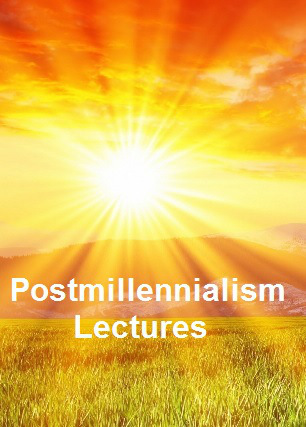

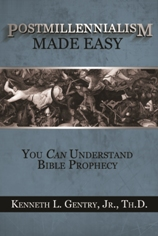
June 3, 2022
DID ANIMALS DIE IN EDEN?
PMW 2022-058 by Kenneth L. Gentry, Jr.
Numerous arguments demand that animal death results from God’s curse on creation after Adam’s fall, rather than being a feature of God’s original creational activity. Consider the following:
FIRST, by divine decree man and animals were herbivorous originally. In Genesis 1:29-30 God grants only vegetation for food, for both man and animals. As Hamilton notes regarding man’s dominion over the animals: “such dominion does not allow him to kill these creatures or to use their flesh as food. Only much later (9:3, post-Flood) is domination extended to include consumption” (Hamilton, 139). He continues: “Man is to have as his food the seed and fruit of plants. Animals and birds are to have the leaves. . . . At no point is anything (human beings, animals, birds) allowed to take the life of another living being and consume it for food. . . . What is strange, and probably unexplainable (from a scientific position), is the fact that the animals too are not carnivores but also vegetarians” (Hamilton, 140; cp. Wenham, 33).
UNDERSTANDING THE CREATION ACCOUNT (5 DVDs)
by Ken Gentry
These formal conference lectures present important information for properly approaching the Creation Account in Genesis. They lay the groundwork for analyzing the text by means of sound exegetical methodology. In doing so, they defend the view that God created the universe in six, twenty-four days. They do not give an exposition of the six day process, but show why it is the necessary result of reading the Creation Narrative.
See more study materials at: www.KennethGentry.com
SECOND, the “death” of vegetation is of a qualitatively different order, and not as a result of divine curse, for:
(1) God expressly designs vegetation alone for food consumption (Ge 1:29-30).
(2) Plants lack a nephesh, unlike animal and man (Ge 1:20, 24, 30; 2:7). In fact, both animal (Ge 1:20-21, 24; 9:10) and man (Ge 2:7) are called “living creatures” (nephesh hayah). Of Genesis 1:20-24, Waltke explains: “Man is here being associated with the other creatures as sharing in the passionate experience of life and is not being defined as distinct from them.”
(3) Plants do not possess the “breath (ruach) of life,” as do animals and man (Ge 6:17; 7:15, 22).
(4) Scripture never ponders the loss of a plant’s ruach, as it does animal’s and man’s (Ecc 3:20); in fact, a similarity exists between man’s ruach and animal’s (Ecc 3:19).
(5) When animal life “returns to the dust” it is because God “hides his face” (Ps 104:29). Scripture does not present God responding to plant death in such a way.
THIRD, the creation account does not record God’s “blessing” creation until the creation of sentient life on Day 5 (Ge 1:22). By this means of blessing, God draws a distinction between the zoological and the botanical orders of life. In that “blessing” often implies fecundity — which plants also have (Ge 1:11-12) — the lack of God’s “blessing” plant life indicates this divine benediction is more than endowing living organisms with the capacity to multiply (contra Kline, “Space and Time,” 6; Irons, 28).
FOURTH, Paul relates the effects of the curse upon the creation in such a way that surely implies the post-fall creation must be quite different from the original, uncursed world. He even strongly suggests that animal death is a consequence of it: “For the creation was subjected to futility, not of its own will, but because of Him who subjected it, in hope that the creation itself also will be set free from its slavery to corruption into the freedom of the glory of the children of God. For we know that the whole creation groans and suffers the pains of childbirth together until now” (Ro 8:20-23). Note that this “slavery to corruption” and “groaning and suffering” result from God’s “subjecting creation to futility” — obviously by divine curse.
In fact, according to the Westminster Larger Catechism 29: “The punishments of sin in this world are either inward, as blindness of mind, a reprobate sense, strong delusions, hardness of heart, horror of conscience, and vile affections; or outward, as the curse of God upon the creatures for our sakes, and all other evils that befall us in our bodies, names, estates, relations, and employments; together with death itself.” According to Murray, the bondage of corruption in the creation itself (Ro 8:21) “must be taken in the sense of the decay and death apparent even in non-rational creation.” (For more information on this matter see later arguments.)
AS IT IS WRITTEN (by Ken Gentry)
The framework hypothesis or literary framework view has grown in acceptance as more readers of Scripture place “science” as the authority over the interpretation of God’s Word. By re-interpreting Genesis, this view encourages Christians to disregard the plainly declared timeline of creation (the majestic march of days of Genesis 1) and instead consider it as merely figurative or poetic rather than historical and accurate. Kenneth Gentry carefully defines the framework hypothesis, while tracing its historical origins and purpose. This provides a helpful introduction both for those who know the framework hypothesis as well as any hearing the term for the first time.
May 31, 2022
MISTAKEN DISMISSALS OF POSTMILLENNIALISM (4)
 PMW 2022-042 by Greg L. Bahnsen (edited by Kenneth L. Gentry, Jr.)
PMW 2022-042 by Greg L. Bahnsen (edited by Kenneth L. Gentry, Jr.)
(Gentry note: This is the fourth in a four-part series on “Misguided Grounds for Rejecting Postmillennialism.” This article was originally written by Dr. Greg L. Bahnsen, but is presented here as edited by Kenneth L. Gentry, Jr. In this article, Dr. Bahnsen considers “Premature Charges.”)
In addition to the misguided and failed attempts to dismiss postmillennialism based on (1) newspaper exegesis, (2) misrepresentation, and (3) the application of two-edged criticism (which applies to the critic as well as the position criticized), there are current day charges against the position which are premature or unfounded.
To this category belongs the allegation that postmillennialism is founded on Old Testament passages rather than New Testament evidence,[1] that the New Testament knows nothing of the proclamation of a semi-golden age.[2] Such statements do not bear their own weight in the face of postmillennial appeals to New Testament passages like the kingdom growth parables of Matthew 13, the apostle John’s teachings about the overcoming of Satan and the world (e.g., John 12:31-32; 16:33; I John 2:13-14; 3:8; 4:4, 14; 5:4-5), Peter’s Pentecost address (Acts 2:32-36, 41), Paul’s declaration that all Israel shall be saved (Rom. 11:25-32), his resurrection victory chapter in I Corinthians 15 (esp. vss. 20-26, 57-58), the statements of Hebrews 1-2 about the subjection of all enemies to Christ in the post-ascension era (1:8-9, 13; 2:5-9), and numerous passages from Revelation, notably about the vastness of the redeemed (7:9-10), the open door for missionary triumph and the Christian’s reign with Christ over the nations (2:25-27; 3:7-9), the submission of the kingdoms of this world to the kingdom of Christ (11:15), and the utter victory of gospel proclamation (19:11-21). Opponents of postmillennialism may wish to dispute its interpretation of such passages, but it is groundless for them to allege without qualifications and without detailed interaction with postmillennial writings that the position is not taken from the New Testament itself.
Thine Is the Kingdom
(ed. by Ken Gentry)
Contributors lay the scriptural foundation for a biblically-based, hope-filled postmillennial eschatology, while showing what it means to be postmillennial in the real world.
See more study materials at: www.KennethGentry.com
Further premature criticisms would include Walvoord’s accusation that postmillennialism obscures the doctrine of Christ’s second coming by including it in God’s providential works in history,[3] and Adams’ charge that it confounds the millennium with the eternal state – since it takes Old Testament prophecies of kingdom peace and prosperity and illegitimately applies them to the New Testament mention of the millennium, and thereby winds up with the dilemma that either there is no need for a new heavens and earth (to which the Old Testament prophecies really apply) or else the millennium is frustrated.[4]
Walvoord has failed to grasp adequately the postmillennialist’s philosophy of history; it is not the case that the postmillennialist fails to distinguish providence from consummation, but rather that he sees providence as well orchestrated to subserve the ultimate ends of consummation. And in connection with this understanding, he recognizes that the New Testament speaks of Christ “coming” in various ways (contrary to Walvoord’s apparent thought that there is only one single sense in which Christ “comes,” namely, at his return in glory) – for example, in the first-century establishment of his kingdom (Matt. 16:28), in the person of the Holy spirit at Pentecost (John 14:18, 28; cf. vs. 16; Acts 2:33; I Cor 15:45; II Cor. 3:17), in fellowship with the repentant and obedient believer (Rev. 3:20; John 14;21-23), in historical judgment upon nations (Matt. 24:29-30, 34; Mark 14:61-62), and upon churches (Rev. 2:5, 16). Such “comings” of the Lord are part of God’s providential government of pre-consummation history and are in addition to Christ’s visible and glorious coming in final judgment (II Thess. 1:7-10). The postmillennialist does not obscure the second coming with providence.
Nor does he, as Adams said, confound the millennium with the eternal state; the postmillennialist clearly knows the difference between the two. It is just that he disagrees with Adams that certain Old Testament prophecies pertain exclusively to the eternal state. Prior to the amillennialists and postmillennialists engaging in full exegetical debate over such passages, it would be just as legitimate for the postmillennialist to accuse Adams of confounding the eternal state with the millennium. The postmillennialist has a sound rationale for connecting relevant Old Testament passages with the New Testament millennium, in that these passages (according to postmillennialist claims) speak of the pre-consummation prosperity of Christ’s kingdom, and the millennium is precisely the pre-consummation form of his kingdom. Such Old Testament passages are taken to be (at least in part) predictions concerning a pre-consummation state of affairs because they speak of things which are inappropriate to the eternal state (e.g., opposition to the kingdom, evangelism, kingdom growth, national interaction, death, etc.). Again, the opponents of postmillennialism may dispute its interpretation of such passages, but it is premature to accuse the position of confounding two openly recognized distinct entities (namely, the millennium and eternity) prior to refuting the exegetical reasoning of the position. Postmillennialism is not suspect in advance, any more than amillennialism is.
YOUR HOPE IN GOD’S WORLD (DVD lectures) by Ken Gentry
This series of lectures presents the theological and exegetical argument for the postmillennial hope in our fallen world. The last lecture answers the major practical, theological, and exegetical objections to postmillennialism. An excellent series for both introducing and refreshing one’s understanding of postmillennialism.
See more study materials at: www.KennethGentry.com
A further groundless criticism of postmillennialism as a system is Adams’ claim that it has even less reason to expect a semi-golden age in history than does the premillennialist, since there is nothing but sinful, non-glorified humanity to produce it, and that it has no explanation for the anticipated sudden change of conditions in the world at the end of history.[5] Such statements are unwarranted, for the postmillennialist sees the powerful presence of Christ through the Holy spirit as sufficient reason to expect the release of Satan from the post-resurrection restraints on his deceiving power over the nations as adequate explanation of the change of world conditions at the very end of the age (just as Adams does). Such tenets have been made well known in postmillennial teaching, and thus Adams’ criticism is an obvious oversight of what is an important element of the position criticized.
A similar reply is called for with respect to Walvoord’s criticism that postmillennialism deprives today’s believer of the hope of Christ’s imminent return.[6] The fact is that postmillennial never claimed to salvage the doctrine of the any-moment return of Christ; indeed, distinctive to it is the denial of the imminent physical return. The New Testament definitely indicates that the coming of the Lord is a delayed event, and that the Christian should expect to see precursor signs of its approach.[7] It is not to come upon him as an unexpected thief (I Thess. 5:4), for he believes the Scriptures that certain things must first occur (cf. II Thess. 2:1-3, etc.). Indeed, it was the error of the foolish virgins to expect the imminent coming of the bridegroom (Matt. 25:1-8). Hence postmillennialism can hardly be faulted for not preserving a doctrine which it does not, by the very nature of its position, think should be preserved (cf. Matt. 25:5, 10).
We must conclude, then, that current day writers have offered no good prima facie reason for ignoring or rejecting postmillennialism as an important theological option for biblical believers. It has been unwarrantedly dismissed in the past fifty years on the basis of newspaper exegesis, misrepresentation, two-edged criticisms, and premature or unfounded charges. Postmillennialism deserves to be taken seriously and considered in the light of Scripture; quick dismissal or ignoring of it in recent years has no good justification.
Notes
George L. Murray, Millennial Studies (Grand Rapids: Baker, 1960), 86-87.Jay E. Adams, The Time Is at Hand (Nutley, N. J.: Presbyterian and Reformed, 1970),13.John F. Walvoord, The Millennial Kingdom (Grand Rapids: Zondervan, 1959), 33.Adams, The Time Is at Hand, 9, 14, 99; Adams applies these comments to “unrealized millennialists,” among whom he counts postmillennialists.Adams, The Time Is at Hand, 12, 87.Walvoord, The Millennial Kingdom, 32-33.Cf. O. T. Allis, Prophecy and the Church (Philadelphia: Presbyterian and Reformed, 1945), 173-174. This fact should clearly not be taken to imply that the Christian knows the actual day or hour of Christ’s return; Christ did not even claim such knowledge (Mark 13:32), and it is not for us to know God’s secret decree for the commencement of this event (Luke 12:40; Acts 1:6). Our duty is simply to be in faithful preparation for it (Matt. 24:46; 25:19-23; Mark 35-36).Click on the following images for more information on these studies:




May 27, 2022
MISTAKEN DISMISSALS OF POSTMILLENNIALISM (3)
 PMW 2022-041 by Greg L. Bahnsen (edited by Kenneth L. Gentry, Jr.)
PMW 2022-041 by Greg L. Bahnsen (edited by Kenneth L. Gentry, Jr.)
(Ken Gentry note: This is the third in a four-part series on the sad practice of rejecting postmillennialism on faulty grounds. Dr. Bahnsen wrote this material and Kenneth L. Gentry, Jr., has edited it and offered here. This rejection falls on its own sword in that it involves two-edged criticisms. Let’s see how this is so.)
A third infelicitous way in which postmillennialism has been disposed of is by means of (allegedly) critical considerations which in fact apply as much to the other eschatological positions as to postmillennialism. This is particularly embarrassing as a scholarly lapse. But what do we mean?
One example, is that some have contended that there is incoherence among various postmillennialists rather than a unified theology, and in connection with this criticism it is observed that postmillennialism is adhered to by extremely divergent theological schools.[1] However, this is just as true of amillennialism and premillennialism; numerous details differ among proponents of these positions (indeed, one is inclined to think that they are more extensive and significant differences than those among proponents of these positions (indeed, one is inclined to think that they are more extensive and significant differences than those among postmillennialists), but this says nothing about the truth of their central tenets. Perhaps the clearest evidence of this problem is the strong antipathy that historic premillennialists (such as George Eldon Ladd, G. M. Beasley-Murray) have toward dispensational premillennialists. And the dispensationalists recognize this strong criticism of their position (as we see for instance in Ryrie’s, Dispensationalism).
THE HARROWING OF HELL (postmillennialism) by Jay Rogers
This book examines the power of the Gospel, not only to overcome all opposition, but to rise far above the powers of hell. The term “Harrowing of Hell” refers to idea that Christ descended into Hell, as stated in the Apostles’ Creed. It is further thought (by some, but by no means all) to mean that He made warfare against hell releasing its captives, particularly the righteous men and women of Old Testament times.
See more study materials at: www.KennethGentry.com
Then again, postmillennialism is sometimes thought to be falsified through imputing guilt to it by association, observing that it has sometimes been held in some form by unitarians and liberals. But “premillennialism” has been advocated by the apostate Jews and modern cultists, and “amillennialism” is endorsed by neo-orthodox dialectical theology.
The fact that there are functional similarities between various evangelical and heretical theologians does not in itself settle the key question of which position is taught by God’s word; whichever millennial position is scriptural, it is nonetheless subject to misuse and inappropriation. Hence the use of one of these positions by an unorthodox writer does nothing in itself to discredit the position.
A further criticism which cannot be applied uniquely to postmillennialism is that it interprets biblical prophecy both figuratively [2] and literally.[3] The premillennialists see symbolic interpretation as a failure of nerve, and amillennialists take literal understanding of prophecy as crude and insensitive. But the fact remains that none of the three schools interprets biblical prophecy exclusively in either a literal or figurative fashion. (And, by the way, nobody really adheres to the rule, “Literal where possible,” as is evident from the respective treatments of the beast of Revelation, which could possibly be a literal monster but obviously is not.)
POSTMILLENNIALISM: EXPLAINED, DEFENDED AND APPLIED (5 mp3)
These five downloadable lectures explain the biblical foundations to postmillennialism, while providing practical applications for the modern Christian. Some of the leading objections are dealt with a clear and succinct fashion. Includes Q&A after each session and a downloadable syllabus.
For more study materials see: KennethGentry.com
All three eschatological schools end up finding both kinds of literature in the prophetic passages, and it is dishonest to give an opposite impression. If anything, the fact that postmillennialism is seen as too literal by amillennialists and too figurative by premillennialists perhaps suggests (certainly does not prove) that it alone has maintained a proper balance. The upshot is this: the charge of subjective spiritualization or hyperliteralism against any of the three eschatological positions cannot be settled in general; rather, the opponents must get down to hand-to-hand exegetical combat on particular passages and phrases.
Notes
1. John F. Walvoord, The Millennial Kingdom (Grand Rapids: Zondervan, 1959), 23, 34, 36.
2. Walvoord, The Millennial Kingdom, 24-25, 34.
3. William E. Cox, Amillennialism Today (Philadelphia: Presbyterian and Reformed, 1966), 20, 136; Jay E. Adams, The Time is at Hand (Nutley, N. J.: Presbyterian and Reformed, 1970), 15.
Click on the following images for more information on these studies:

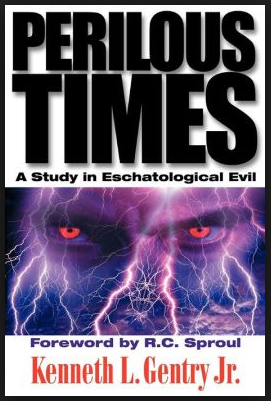
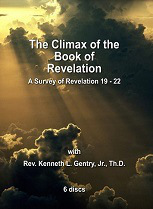

May 24, 2022
MISTAKEN DISMISSALS OF POSTMILLENNIALISM (2)
 PMW 2022-040 by Greg L. Bahnsen (edited by Kenneth L. Gentry, Jr.)
PMW 2022-040 by Greg L. Bahnsen (edited by Kenneth L. Gentry, Jr.)
This is the second in a four-part series on “Misguided Grounds for Rejecting Postmillennialism.” This article was originally written by Dr. Greg L. Bahnsen, but is presented here as edited by Kenneth L. Gentry, Jr. In this article, Dr. Bahnsen considers “Misrpresentation.”
Misrepresentation Documented
Postmillennialism has not only been discarded in this century on clearly unorthodox grounds; it has also been made a straw man so that modern advocates of the other schools of interpretation can easily knock it down and get on to other interests. The worst possible interpretation is put on postmillennial tenets, or the eccentric aspect of some postmillennial writer’s position is set forth as representing the basic school of thought.
As instances of these procedures we can note the following. Hal Lindsey says that postmillennialists believe in the inherent goodness of man,[1] and Walvoord says that the position could not resist the trend toward liberalism.[2] He also accuses it of not seeing the kingdom as consummated by the Second Advent.[3] William E. Cox claims that postmillennialism is characterized by a literal interpretation of Revelation 20.[4] Adams portrays the postmillennialist as unable to conceive of the millennium as coextensive with the church age or as a present reality,[5] for he (according to Adams) must see it as exclusively future – a golden age just around the corner.[6]
Pushing the Antithesis (by Ken Gentry)
Sub-title: The Apologetic Methodology of Greg L. Bahnsen
See more study materials at: www.KennethGentry.com
Finally, it is popularly thought and taught that postmillennialism maintains that there is an unbroken progression toward righteousness in history – that the world is perceptibly getting better and better all the time – until a utopian age is reached. Geerhardus Vos portrays the postmillennialist as looking for “ideal perfection” when “every individual” will be converted, and some will become “sinless individuals.”[7]
All of the above claims are simply inaccurate. The Calvinist, Loraine Boettner, certainly does not believe in man’s inherent goodness, and B. B. Warfield can hardly be accused of not resisting liberalism. That A. A. Hodge did not see the second coming of Christ as the great day of consummation is preposterous.
In addition, J. Marcellus Kik and many others insisted on a figurative interpretation of Revelation 20. Certain sixteenth- and seventeenth-century Dutch theologians, as well as Jonathan Edwards and E. W. Hengstenberg, were all postmillennialists who saw the millennium as coeval with the interadventual age (in which there would be progressive growth for the church in numbers and influence). Charles Hodge, Snowden, and Boettner were all postmillennialists who explained that the growth of Christ’s kingdom in the world suffers periodic crises, and Boettner has especially stressed the fact that it grows by imperceptible degrees over a long period.
THE BOOK OF REVELATION AND THE POSTMILLENNIAL HOPE (DVD lectures)
Three lectures by Ken Gentry. Many Christians deem Revelation to be contrary to the postmillennial hope. The judgments therein appear to be so severe and wide-ranging that any hope for the worldwide conquest of the gospel would seem to be impossible. Dr. Gentry explains the judgments of Revelation in such a way that they clearly do not contradict postmillennialism. In fact, he shows that they actually pave the way for it.
See more study materials at: www.KennethGentry.com
Finally, anyone who thinks of postmillennialism as a utopian position misunderstands one or the other in their historically essential principles. Indeed, a chapter in Boettner’s book, The Millennium, is entitled, “The Millennium not a Perfect or Sinless State,” contrary to the misrepresentations of Vos. Nobody has ever propounded, in the name of evangelical postmillennialism, what Vos claimed (least of all his Princeton colleagues or predecessors). Therefore, the recent opponents of postmillennialism have not been fair to its genuine distinctives, but rather have misrepresented it as a general category of interpretation. This surely provides no firm ground for rejecting the position.
Misrepresentation Cures
All of this misrepresentation could easily be cured by three simple correctives:
First, the opponent of postmillennialism should read its leading, current-day representatives, not simply secondary sources bent on rejecting the eschatological system.
Second, the opponent should also read these representatives carefully. Some of the denunciations of postmillennialism cite the appropriate articles and books, but do so in an anti-contextual manner. All theological statements should be read in their contexts rather than jerked from them.
Third, he should have in mind an adequate definition of postmillennialism (such as Gentry gives in an earlier post: “Definining Postmillennialism”). How can you reject something of which you have no working definition? But such is the large-scale practice in evangelical debate today.
Notes
Hal Lindsey (with C. C. Carlson), The Late Great Planet Earth (Grand Rapids: Zondervan, 1970), 176.John F. Walvoord, The Millennial Kingdom (Grand Rapids: Zondervan, 1959), 34.Walvoord, The Millennial Kingdom, 31.William E. Cox, Amillennialism Today (Philadelphia: Presbyterian and, 1966), 64.Jay E. Adams, The Time is at Hand (Nutley, N. J.: Presbyterian and Reformed, 1970), 90.Adams, The Time is at Hand, 2, 41.Geerhardus Vos, “Outline of Notes on New Testament Biblical Theology,” 89, 90.Click on the following images for more information on these studies:



May 20, 2022
MISTAKEN DISMISSALS OF POSTMILLENNIALISM (1)
 PMT 2016-001 by Greg L. Bahnsen (edited by Kenneth L. Gentry, Jr.)
PMT 2016-001 by Greg L. Bahnsen (edited by Kenneth L. Gentry, Jr.)
Introduction by Ken Gentry
Postmillennialism is perhaps the easiest eschatological system to misunderstand. And misunderstanding leads to rejection. This is the first in a four-part series on “Misguided Grounds for Rejecting Postmillennialism.” This article was originally written by Greg L. Bahnsen, but is presented here as edited by Kenneth L. Gentry, Jr. In this article, Bahnsen considers the problem of “Newspaper Exegesis.”
Newspaper Exegesis
It must be observed that postmillennialism lost favor (and today remains held in disfavor) with conservative theologians for manifestly unorthodox and insufficient reasons. Extra-biblical reasoning, as well as lazy or poor scholarship, has intruded itself into Christian discussions of eschatology. I will highlight four misguided grounds often used for rejecting this hope-filled eschatology. In this article I will focus on: Newspaper Exegesis.
Alva J. McClain says of postmillennialism: “This optimistic theory of human progress had much of its own way for the half-century ending in World War I of 1914. After that the foundations were badly shaken; prop after prop went down, until today the whole theory is under attack from every side. Devout Postmillennialism has virtually disappeared.”[1] J. Barton Payne’s massive Encyclopedia of Biblical Prophecy mentions postmillennialism only once, and that merely in a footnote which parenthetically declares “two world wars killed this optimism.”[2] Merrill F. Unger dismisses postmillennialism in short order, declaring: “This theory, largely disproved by the progress of history, is practically a dead issue.”[3] John F. Walvoord tells us that “In eschatology the trend away from postmillennialism became almost a rout with the advent of World War II” because it forced upon Christians “a realistic appraisal of the decline of the church in power and influence.”[4] Hence he says that “In the twentieth century the course of history,
progress in Biblical studies, and the changing attitude of philosophy arrested its progress and brought about its apparent discard by all schools of theology. Postmillennialism is not a current issue in millenarianism.”[5] He accuses it of failing to fit the facts of current history, of being unrealistic, and of being outmoded and out of step.[6]
Prodigal Press:
Confronting the Anti-Christian Bias of the American News Media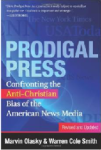
By Marvin Olasky and Warren Cole Smith
Issuing a clarion call for Christians to reclaim American journalism, Olasky and Smith examine the influence of worldviews on reporting, objectivity, sensationalism, and crusading; the impact of legal, ethical, and technological changes; and the changes brought about by the 24/7 news cycle, the Internet, and social media.
See more study materials at: www.KennethGentry.com
Jay Adams recognizes postmillennialism as a “dead issue” with conservative scholars, since it predicts a golden age while the world awaits momentary destruction; he agrees with the above authors that the “advent of two World Wars . . . virtually rang the death knell upon conservative postmillennialism.”[7] Adams apparently offers his own opinion that Boettner’s long-range postmillennialism “is too difficult to grant when Christians must face the fact of hydrogen bombs in the hands of depraved humanity.”[8] Hal Lindsey’s The Late Great Planet Earth captures well the attitude of these previous writers, stating that “there used to be” a group called “postmillennialists” who were greatly disheartened by World War I and virtually wiped out by World War II. Lindsey’s (poorly researched) conclusion is this: “No self-respecting scholar who looks at the world conditions and the accelerating decline of Christian influence today is a ‘postmillennialist.’”[9]
The sad fact is that our Christian brothers mentioned above should be embarrassed by what they have written and concluded; the attitude and reasoning they have set forth is woefully lacking as respectable Christian scholarship. By means of such newspaper exegesis, one could just as well discount the return of Christ in glory, saying “where is the promise of his coming?” (cf. II Peter 3:1-4). This reductio ad absurdum must be reckoned with. The fact that an era of gospel prosperity and world peace has not yet arrived would no more disprove the Bible’s teaching that such an era shall be realized (in the power of God’s spirit and the faithfulness of Christ’s church to its great commission) than the fact that Christ has not yet returned disproves the Bible’s teaching that such an event shall take place!
The only question is whether the Bible actually teaches these things. If it does, then “let God be true but every man a liar” (Rom. 3:4). The newspaper has no prerogative to challenge God’s word of truth. Nor do those who read the newspapers. As faithful disciples of Christ, we are to trust God as the sovereign controller over human history, “who works all things after the counsel of His own will” (Eph. 1:11), “declaring the end from the beginning and from ancient times things not yet done, saying, ‘My counsel shall stand, and I will accomplish all my purpose’” (Isa. 46:10), so that “none can stay his hand” (Dan. 4:35). With the Psalmist we should declare, “Whatever the Lord pleases, he does, in heaven and on earth” (115:3). If God says something is to happen, then it shall happen; it is to our discredit if we are men of little faith with respect to his promises.
Standard Bearer: Festschrift for Greg Bahnsen (ed. by Steve Schlissel)
Includes two chapters by Gentry on Revelation and theonomy.
See more study materials at: www.KennethGentry.com
Just imagine the following scenario: devout Simeon is in the temple looking for the consolation of Israel (cf. Luke 2), when a popular Jewish theologian comes in and tells him, “Simeon, your hope of a personal Messiah is a dead issue, an idealistic anachronism. Your unrealistic theory has been disproved by the course of history and discarded by all schools; it is out of date, outmoded, and no longer a current issue. No self-respecting scholar who looks at the world conditions and remembers the four hundred years of silence from God believes as you do; prop after prop has gone down, and the events that have come upon our nation have killed the optimism of your theory.” Would any conservative theologian say that Simeon’s belief had been refuted or incapacitated by such considerations? Would any think him justified in no longer treating it as a vital position worthy of scriptural consideration? Of course not. Likewise biblical postmillennialism cannot be thus dismissed.
Notes
“Premillennialism as a Philosophy of History,” in W. Culbertson and H. B. Centz, eds., Understanding the Times (Grand Rapids: Zondervan, 1956), 22.J. Barton Payne, Encyclopedia of Biblical Prophecy (New York: Harper and Row, 1973), 596.“Millennium,” Unger’s Bible Dictionary (Chicago: Moody, rev. 1961), 739.John F. Walvoord, The Millennial Kingdom (Grand Rapids: Zondervan, 1959), 9.Walvoord, The Millennial Kingdom, 18.Walvoord, The Millennial Kingdom, 35, 36.Jay E. Adams, The Time is at Hand (Nutley, N. J.: Presbyterian and Reformed, 1970), 2.Adams, The Time is at Hand, p. 4.Hal Lindsey (with C. C. Carlson), The Late Great Planet Earth (Grand Rapids: Zondervan, 1970), 176.Click on the following images for more information on these studies:


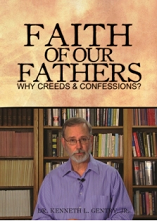
May 17, 2022
IS THE “END OF THE AGE” AD 70?
 PMW 2022-038 by Kenneth L. Gentry, Jr.
PMW 2022-038 by Kenneth L. Gentry, Jr.
I am not always able to engage in theological discussion by email, due to my time constraints and the number of requests for such that I receive. But occasionally I will engage a discussion briefly. Here is one I just had with a PostmillennialWorldview reader. It regards the two-age structure of history.
PMW reader wrote:
I have a question to throw in the works if I may: Matthew 24:3 says ” What will be the sign of your coming and of the end of the age?”
This could mean the end of the Old Testament age. I back this up with Jesus comments on the blasphemy against the Holy Spirit, which will not be forgiven “in this age or the age to come” (Matthew 12:32.)
“This age” – the old Testament age in which Jesus was at the time. “The age to come” the New Testament age. The Age to Come could not mean heaven or after Christ’s return because there is no sin in that age.
My reply:
Actually I believe that “this age” is history and the “age to come” is eternity.
In Luke 20:34-36 we read: “Jesus said to them, ‘The sons of this age marry and are given in marriage, but those who are considered worthy to attain to that age and the resurrection from the dead, neither marry nor are given in marriage; for they cannot even die anymore, because they are like angels, and are sons of God, being sons of the resurrection.’”
Jesus’ statement that blasphemy will not be forgiven in this age or the age to come means it will never be forgiven.
Perilous Times: A Study in Eschatological Evil (by Ken Gentry)
Technical studies on Daniel’s Seventy Weeks, the great tribulation, Paul’s Man of Sin, and John’s Revelation.
See more study materials at: www.KennethGentry.com
PMW reader responds:
Thank you for your prompt reply – please know that I do not intend to argue but to understand – hence my questions and proposals.
Where I am coming from in this discussion is the belief that the death of our Lord was a far more important event than many Christians realise. And therefore that our present age, the church age is very different from the previous Jewish dispensation. Here I refer to James Kennedy with “What if Jesus had never been born?” The earth would probably degenerated back into the immediate preflood era – filled with violence, whereas now the forces of darkness fight a long retreat as the forces of the Lord progressively occupy until He comes. I also cite Oswald Chambers concerning the death of Christ as well as my fellow South African, J J van den Burg, in his Gospel According to Luke.
God is making all things new from the inside out as it were – whereas the original creation was “top down” and ending with the creation of man, first his body then finally his spirit, breathed into him by God, the New Creation begins with the creation of the new race of humans – in the reverse order first the new spirit in the born again experience…. There are now two species of humans on the planet ! – the saved and the lost.
As we Postmillenialists believe, this age, the church age ends very well, precisely because of the death of Christ !
My reply:
I agree with your disappointment that Christians do not better comprehend the implications of Christ’s death and the changes he effected thereby. For instance, he began in spiritual principle the new creation.
Actually, because of Christ the present age (history) is being impacted by the age to come (eternity). We see this in that we are new creations (2 Cor 5:17; Gal 6:15), are spiritually resurrected (John 5:24-27; Eph 2:6), and so forth. We live in the now / not yet era of mixed realities: we are in the old creation though we are new creation beings.
The Beast of Revelation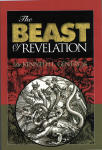
by Ken Gentry
A popularly written antidote to dispensational sensationalism and newspaper exegesis. Convincing biblical and historical evidence showing that the Beast was the Roman Emperor Nero Caesar, the first civil persecutor of the Church. The second half of the book shows Revelation’s date of writing, proving its composition as prior to the Fall of Jerusalem in A.D. 70. A thought-provoking treatment of a fascinating and confusing topic.
For more study materials, go to: KennethGentry.com
Thus, we live in the great overlap of the ages. But we are only in the overlap, not the fullness of the age to come. We have “tasted the powers of the age to come” (Heb 6:5). This does distinguish the new covenant era from the old covenant era, but we still endure old covenant era physical death and so forth, which is a characteristic of the present age.
Therefore the end of the age has not yet come, consequently we are to continue evangelizing (Matt 28:20) because the unbelievers have not yet been finally separated from the believers (Matt 13:39-40, 49). And we are to continue instructing men to deny ungodliness in this age (Tit 2:12). And we remain “sons of this age” because we marry and are given in marriage (Luke 20:34).
May 13, 2022
IS THE SECOND ADVENT “IMMINENT”? (2)
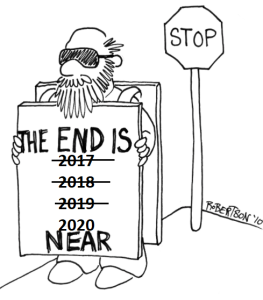 PMW 2022- by Kenneth L. Gentry, Jr.
PMW 2022- by Kenneth L. Gentry, Jr.
In my last article I opened a brief analysis of the doctrine of the imminent return of Christ. I began setting up the matter and also showing its problems for dispensationalism. In this article I will conclude the study.
Often dispensationalists try to distinguish between Christ’s return being imminent and its being soon. This strives to protect them against charges of date-setting. This does not protect them from the charge, however, because it is inconsistently held.
In a letter to me dated June 1, 1994, from Thomas D. Ice, Executive Director of the Pre-Trib Research Center, Ice writes: “We distinguish between imminent and soon in the sense that soon would require a near coming, while imminent would allow, but not require a soon coming.” Bundled in that very letter was his first newsletter entitled: “The Pre-Trib Research Center: A New Beginning.” The first sentence of the newsletter (once past the headings) was: “Our purpose is to awaken in the Body of Christ a new awareness of the soon coming of Jesus.” The system giveth and taketh away. In fact, in a book edited by Ice, Tim LaHaye speaks of “the soon coming of Christ.”
Ironically, dispensationalists should be the last people to seek signs of the approaching end, for such a quest undermines their most distinctive doctrine: the ever-imminent, sign-less, secret rapture. Yet, date-setting has long plagued premillennialism, especially dispensationalism. The last twenty years are particularly rife with cries of the approaching end. In 1990–91 needless American fears over the 30-day Gulf War — Iraq’s great tribulation — fuel the flames of date-setting, much like in World War I. Hal Lindsey writes: “At the time of this writing, virtually the entire world may be plunged into a war in which this city [Babylon] may emerge with a role and destiny that few have any inkling of.” Later he sums up: “This is the most exciting time to be alive in all of human history. We are about to witness the climax of God’s dealing with man.” LaHaye’s chapter in When the Trumpet Sounds (1995) is titled “Twelve Reasons Why This Could Be the Terminal Generation.”
Even noted dispensational theologians are engaging in date-setting. Ironically, in the summer of 1990, as the Gulf War clouds loomed, Walvoord’s book review appeared in which he wrote disparagingly of my insistence that dispensationalists are date-setters: “So premillennialism and dispensationalism have been derided as a date-setting system of doctrine, even though very few of its adherents indulge in this procedure.” But in 2001 Walvoord writes: “Many indications exist that human history is reaching its climax in end-time events.”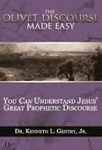
Olivet Discourse Made Easy (by Ken Gentry)
Verse-by-verse analysis of Christ’s teaching on Jerusalem’s destruction in Matt 24. Shows the great tribulation is past, having occurred in AD 70, and is distinct from the Second Advent at the end of history.
See more study materials at: www.KennethGentry.com
The New Testament teaches, however, that the Lord’s glorious, bodily return will be in the distant and unknowable future. It is neither imminent nor datable. Bahnsen notes that “distinctive to [postmillennialism] is the denial of the imminent physical return” of Christ. Mathison agrees: “Scripture simply does not teach the dispensational doctrine of the ‘imminent’ return of Christ.”
Christ’s return has not been imminent since the ascension. Jesus clearly teaches: “While the bridegroom was delayed, they all slumbered and slept” (Mt 25:5). “For the kingdom of heaven is like a man traveling to a far country, who called his own servants and delivered his goods to them. . . . After a long time the lord of those servants came and settled accounts with them” (Mt 25:14, 19). This passage does not expect an any-moment return — indeed, the “wise” virgins prepare for his delayed return.
Just before his ascension Christ deals with a problem among his often-confused disciples (e.g., Mt 16:21–23; Lk 24:25; Jn 20:9): “They asked Him, saying, ‘Lord, will You at this time restore the kingdom to Israel?’ And He said to them, ‘It is not for you to know times [chronos] or seasons which the Father has put in His own authority” (Ac 1:7). Chronos indicates a long period of uncertain duration. In fact, it appears in the plural, which indicates “a rather long period of time composed of several shorter ones.” As premillennialists Blomberg and Chung put it: this “Acts passage utilizes the two broadest words in Hellenistic Greek for ‘time’ (chronos and kairos),” which precludes any “claim to be able to pin down end-times events to any definable period of time.”
Peter seems to reflect this long-term waiting in Acts 3:19, where he speaks of the “times of refreshing” for here “the plural may be intended to convey the idea that it is a long way off” (cf. 2Ti 3:1). According to William Urwick “the only errors mentioned in the New Testament respecting the time of our Lord’s coming, all consist in dating it too early.” We see this problem in the passages I cite above, as well as in the famous passages: 2 Thessalonians 2:1–3 and 2 Peter 3:3–4.
Matthew 28:20 states that the Great Commission will stretch through “all the days” (literal translation of the Greek, pasas tas hemeras). This indicates a great many days before the end. The parables of the mustard seed and leaven set forth a gradually developing kingdom, which grows until it dominates the world’s landscape and penetrates all of the world’s cultures. This surely suggests a long period of time. 2 Peter 3 allows a long delay before Christ’s coming as evidence of the “longsuffering” of God. This fits well with postmillennial eschatology, for it allows time for the advancing victory of Christ’s kingdom and encourages a future-orientation for the church’s labors.
 Dispensational Distortions (3 downloadable mp3s)
Dispensational Distortions (3 downloadable mp3s)
by Ken Gentry
Reformed introduction to classic dispensationalism, with analysis of leading flaws regarding the Church, kingdom, redemptive history, and Christ. Helpful for demonstrating errors to dispensationalists.
See more study materials at: www.KennethGentry.com
A frustrating feature of much amillennialism is the dialectical tension within the system regarding this matter. Amillennialists often hold to contradictory positions, balancing the one (imminency) against the other (a long wait). And they often proclaim this double-speak as a positive merit of the system! For instance, Kim Riddlebarger states: “As we have seen in part 3 in the Olivet Discourse, Jesus taught that his coming is both immanent [sic] (‘this generation will not pass away’) and distant (the parable of the ten virgins). He also taught that specific signs precede his coming and yet that his coming will occur when we least expect it, apparently, after a delay of an indeterminate period of time.” Cornelis Venema concurs: “A balanced and complete reading of the Gospels, therefore, reveals a double emphasis. Some passages emphasize the ‘soon-ness’ or imminence of Christ’s coming; others suggest something of a delay or a considerable period of time intervening.”
But if imminency can cover 2000 years of church history, then postmillennialists have no problem with it. Considered from this perspective, Venema is mistaken when he asserts that “amillennialism has a clearer expectation of the imminence (the ‘soon-ness’) of Christ’s return than does Postmillennialism.” Richard Gaffin holds that “Christ could have returned at virtually any time since the ministry of the apostles.” But if imminency can stretch out for 2000 years (so far!), then imminency is not imminency. How can 2000 years be called “soon-ness”? We cannot reasonably stretch imminency over a 2000 year period, then declare “as the end approaches and the return of Christ becomes ever more imminent.” For then imminency has no meaning: it can fit any time-frame and cannot become “more” imminent.
Interestingly, not all Reformed scholars agree with Riddlebarger, Venema, and Gaffin. John Murray denies the doctrine noting that “the insistence that the advent is imminent is . . . without warrant, and its falsity should have been demonstrated by events.” O. T. Allis and Morton Smith associate imminency doctrine with dispensationalism. Amillennialist Venema can even argue for “the great length of time symbolized in the imagery of the thousand years [in Rev 20],” which covers the entire inter-advental period.
Christ’s return is not datable. Rather than giving specific signs that allow even generalized date-setting, the Scripture forthrightly states: “of that day and hour no one knows, no, not even the angels of heaven, but My Father only” (Mt 24:36). A danger lurks among some who claim to be his people and who may be caught unawares: they will let down their guard because the date is unknowable (Mt 25:1ff). Although prophecy portrays a long era in history in which Christianity will reign supreme, it never gives information allowing us to determine the end. Christ’s glorious rule through his covenant people will be for a long time before he returns in judgment — but for how long, no man knows.
May 10, 2022
IS CHRIST’S RETURN “IMMINENT”? (1)
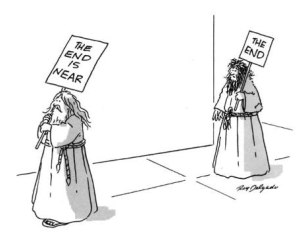 PMW 2019-086 by Kenneth L. Gentry, Jr.
PMW 2019-086 by Kenneth L. Gentry, Jr.
A most remarkable feature of prophetic interest is the Christian’s conviction that we are living “in the shadow of the second coming,” that we are in a “countdown to Armageddon.” We often find linked with a radical misunderstanding of the last days the doctrine of the imminent return of Christ, especially among dispensationalists and premillennialists — but also even with amillennialists.
I will deal with the question in two articles. In this one I will set up the matter; in the next one I will answer it. I will focus largely on the dispensational approach to the question. Interestingly, the doctrine of imminence is simultaneously one of dispensationalism’s most potent drawing cards while being also its most embarrassing error.
John F. Walvoord explains imminency for us: “The hope of the return of Christ to take the saints to heaven is presented in John 14 as an imminent hope. There is no teaching of any intervening event. The prospect of being taken to heaven at the coming of Christ is not qualified by description of any signs or prerequisite events.”
Gerald Stanton states that imminency means the event “is next on the program and may take place at any time.” Indeed, “his coming is next on the revealed program of God.” It is “the next predicted even in God’s prophetic timetable.”
In this 600-page book you will find a thorough presentation and defense of postmillennialism. Postmillennialism offers a positive understanding of the progress of human history before the return of Christ. And it is based on hundreds of biblical references.
For more Christian educational materials: www.KennethGentry.com
Earl D. Radmacher vigorously denies any prophecy is being fulfilled today: “Equally as unjustified as date-setting for Christ’s return are the numerous sermons attempting to find fulfillment of prophecy in this age.”
Unfortunately, Walvoord’s statement clashes with the wider body of his work. In his more recent Prophecy in the New Millennium he dogmatically asserts: “In the centuries of human progress since Adam, the twentieth century deserves its own unique place as an era of unusual prophetic fulfillment that is unequaled in history, except possibly in the first century.” Which is it: (1) The Bible offers “no teaching of any intervening event”? Or (2) the twentieth century is “an era of unusual prophetic fulfillment”? If prophecies are fulfilled in the twentieth century are they not “intervening” events until they occur? Are they not events that must transpire before the end?
In another work, Prophecy Knowledge Handbook, Walvoord even provides a detailed list of the “predicted order of prophetic events related to Israel,” which include the German holocaust, the United Nations action to form Israel as a nation — and more. Thus, “in the predictions that Christ made almost 2,000 years ago, He accurately portrayed the progress in the present age” so that “all these situations have been fulfilled in history.”
LaHaye agrees: “there are more fulfilled signs today than in any previous age.” Lindsey concurs: “This is a unique time in history in which all of the predicted signs that were to precede the Second coming of Christ are coming into focus within the same generation.” Fruchtenbaum follows suit noting of Israel’s reformation as a nation in 1948: “Israelology sees this as a definite fulfillment of prophecy.”
Furthermore, many dispensational theologians hold this imminency doctrine quite inconsistently. For they simultaneously hold that Revelation 2 and 3 outline the entire Church Age up into our own era. For instance, Towns outlines the “history” forecast in the letters, showing that Philadelphia points to 1750–1900, while Laodicea deals with the time from 1900 to the present. (Though he apparently has changed his view in his article in the Dictionary of Premillennial Theology. He must have re-computed the biblical evidence and determined that the Philadelphia era lasts a full ten years more, ending in 1910.) The Popular Encyclopedia of Bible Prophecy holds that the Philadelphia period starts exactly twenty years earlier, it still sees this era as prophetically determined: “Philadelphia — Missionary church (AD 1730–1900).” How could Christ’s return be imminent in the first century if Scripture prophesies events unfolding up through history even to our day? Would these prophecies fail if Christ returns in the second century?
AMILLENNIALISM V. POSTMILLENNIALISM DEBATE (DVD)
Formal, public debate between Dr. Richard Gaffin (Westminster Theological Seminary) and Kenneth Gentry. Amillennialist Gaffin argued that the Christian is called to suffer in this world and should not expect the amelioration of sinful conditions. Postmillennialist Gentry countered that though the Christian should expect and endure suffering in history, ultimately these conditions will be lessened as the gospel expands its influence.
See more study materials at: www.KennethGentry.com
Apparently this problem finally dissuades Walvoord from promoting the view. In his commentary on Revelation he writes: “Many expositors believe that in addition to the obvious implication of these messages the seven churches represent the chronological development of church history viewed spiritually. . . . There does seem to be a remarkable progression in the messages. It would seem almost incredible that such a progression should be a pure accident, and the order of the messages to the churches seems to be divinely selected to give prophetically the main movement of church history.” But twenty-five years later he states: “Some hold that these churches also, in general, represent the history of the church. . . . There is, however, no scriptural verification of this type of interpretation.” Nevertheless, the view still remains popular among dispensationalists.
Even though some dispensationalists attempt to discount this view, they end up with the same problem. For instance, Benware rejects the view but states that the seven churches more generally “represent churches throughout the Church Age, from John’s day until the Rapture.” But if the second coming has been “imminent” since Christ’s ascension, how can Scripture prophesy even the general condition of the church age, which occurs after the ascension, after Pentecost?
To be continued!
Kenneth L. Gentry Jr.'s Blog
- Kenneth L. Gentry Jr.'s profile
- 85 followers



